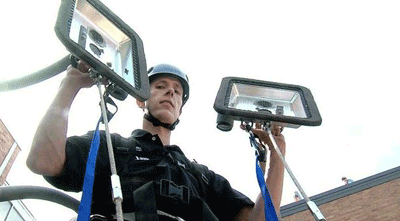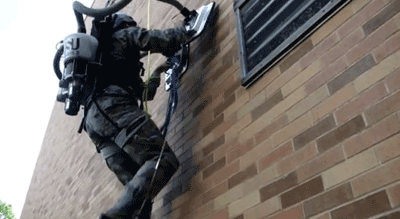Engineer students use vacuum backpack to scale wall without hooks or rope
Project takes first place in the Air Force Research Laboratory’s Design Challenge
Students out of Utah State University used principals learned in engineering and math, along with a whole lot of imagination, to design a vacuum-based device to provide users the ability to climb the broadside of buildings or mountain faces without the aid of grappling hooks or suspended ropes.

USU engineering student holds up vacuum handles used to ascend walls, mountain sides, and more.
The Personnel Vacuum Assisted Climber, or PVAC as the students referred to their project, was part of design challenge sponsored by the Air Force’s Research Laboratory. The contest required applicants to create a device that enabled a person to climb a 90-foot wall faster than technology currently available.
The PVAC was demonstrated at the National Center for Medical Readiness training facility. It took top billing against 33 other design teams from 16 universities, including Arizona State, Johns Hopkins and Brigham Young University.
What they did
Last August, all teams were given $20,000 for materials and fabrication, and nine months to come up with a demonstrable solution. At the time of competition, teams were assessed on objective measures, including weight, size, and velocity, as well as subjective measures, including ease of operation, usability, stealth, innovation, and elegance.
The USU team ended up designing a battery-powered device (30-minutes of power per charge) that allows a person to put both their hands and feet into a spider-like vacuum contraption which, in turn, uses suction to allow the user to climb the wall.

Climber ascends wall using PVAC device.
When the climber gets to the top of the wall, they place adhesive anchors on the top of the structure and then send down a rope strong for other team members to then ascend the wall.
“We went into this competition not knowing what the requirements were going to be,” said TJ Morton, mechanical and aerospace engineering student and team captain. “The competition allowed us to use everything we had learned about in our engineering courses and apply it to a genuine design problem.”
The competition
As part of the competition, all teams had to brief the judges, safety officers, and pararescue jumpers from the 123rd Special Tactics Squadron Air National Guard Unit in Louisville and from Air Force Special Operations Command on their process and final design.
Teams were quizzed by the judges and safety officers, and then grilled by the pararescue jumpers, as the latter group was tasked with actually testing the teams’ systems on the 90-foot high concrete façade of an abandoned cement silo.
Out of all the teams that competed, the USU team was the only one to get all four military personal to the top of the wall.

Military personal use the USU team’s PVAC to ascend building façade.
“The logistics of this project became real very quick,” said team member Dan Aguirre. “Someone was actually relying on our design to climb a wall. You can’t get that in a textbook.”
AFRL Senior Design Scientist for Design Innovation Alok Das, agrees.
“AFRL gets the benefit of some very creative ideas that address a real military need, while the students get an opportunity to work under real-world conditions,” he said. “They gain experience in rapid prototyping and engineering a solution to a customer need, knowing that their design could truly make a difference.”
Video
Below, members of the USU engineer team demonstrate their PVAC project:
Outlook
As part of winning the competition, the USU team was awarded $50,000 in initial grant money to continue working on their invention in order to get it ready for potential military use. If they are successful with improving the current design, the team will secure a $100,000 grant.
Watching the video, it’s easy to tell some of the things that need to be improved. First, the size of the device needs to be reduced. It also needs to be lighter: each pack weighs 48 pounds. Once the climber gets to the top, the rope winch that gets set up is 25 pounds in and of itself. This is simply far too much weight for the contraption to be considered a viable alternative to modern-day wall climbing technology.
The group needs to make the device quieter for stealth operation purposes. They also said that they hope to optimize the system because presently it’s way over-powered, and nowhere near as efficient as it could be. ■
Via: USU.edu
Photos via: theblaze.com
Advertisement
Learn more about Electronic Products Magazine





